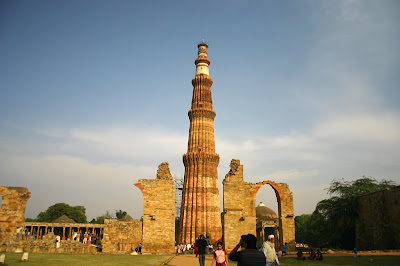Built by the great ruler Sher Shah Suri in the 16th century A.D, the legendaryOld Fort today lies in ruins. The Old Fort or the Purana Qila is also known as the 'Qila-i-kuhna masjid' and has survived the ravages of time. The citadel is a perfect example of Lodi style of architecture. Infact its architecture seems to be a fine blend of the Hindu, Muslim and Afghan style. The fort boasts of awe- inspiring arches and domes along with three double-storied main gates sporting 'chhatris' on its roof top which are found in the north, south and west directions.
 The Old Fort is located quite close to Humayun’s Tomb and India Gate. It is believed that the construction of the fort was started by Humayun, one of the greatest rulers of his dynasty. But later on Sher Shah defeated Humayun, took over the citadel and completed the structure. Also there is a small lake near the Old Fort which caters to the boating facilities for the tourists.
The Old Fort is located quite close to Humayun’s Tomb and India Gate. It is believed that the construction of the fort was started by Humayun, one of the greatest rulers of his dynasty. But later on Sher Shah defeated Humayun, took over the citadel and completed the structure. Also there is a small lake near the Old Fort which caters to the boating facilities for the tourists.
The Fort is made up of red sandstone along with the contrast of marbles and the walls of the fort are 18 metres high. The Purana Quila has three majestic gates - The Humayun Darwaza, the Bara Darwaza and the
Talaqi Darwaza.
The three gates are double storied and built with red sandstone. The Humayun Darwaza and the Bara Darwaza were the two gates that were only meant for entering the fort. Today only the Bara Darwaza is opened for entry. The Talaqui Darwaza is located to the northern side of the fort and entry was prohibited through the Talaqi Darwaza as the name suggests. Talaqi means ‘forbidden'.
The Old Fort houses a number of amazing buildings which include Quila Kuhna Masjid and the Sher Mandal. Both were built by Sher Shah in a grand style. The masjid is built in a fusion of marble and sandstone. There is a prayer hall in the masjid and has five doorways with horse shoe shaped arches.
The Sher Mandal is now an observatory. It was designed for entertainment purpose. The structure and style of the building suggests its architectural magnificence. Once upon a time the Sher Mahal was used by Sher Shah as his own library.
There is a museum at the gate of the Purana Quila which houses important artifacts belonging to the Mughal era. The Old Fort is located at the ancient site of Indraprastha and is believed that there were many instances which were from the Purana Qila in the famous Hindu epic Mahabharata. Potteries have also been found dates back to the days of Mahabharata. The Archeological excavation of the site is proof to the fact that civilization existed here even in 1000 BC.
 This old yet wonderful fort has been a witness to some of the greatest events in the history of India. A visit to the imposing and inspiring Purana Qila should be on your itinerary.
This old yet wonderful fort has been a witness to some of the greatest events in the history of India. A visit to the imposing and inspiring Purana Qila should be on your itinerary. You must not miss the Sound and Light Show at the Old Fort. The show presents the history of the Delhi Old Fort which dates back to 5000 years. The most amazing part is that the nine pools of water come alive in the light which is captivating!
You must not miss the Sound and Light Show at the Old Fort. The show presents the history of the Delhi Old Fort which dates back to 5000 years. The most amazing part is that the nine pools of water come alive in the light which is captivating!
Best time to visit
The best time to visit Delhi is between October and March, when the weather is very pleasant. Most cultural events take place in winter and Delhi is socially very active. By February the flowers are in bloom and the city is really quite pretty then. Summers are searing hot and dry, so do come prepared for the weather.
Trivia
It is believed that Sher Shah could not complete the construction of the Old Fort and it was finished by Humayun. Thus, the well known gate of the fort which is the southern gate is known as Humayun Darwaza.
Timing
You can visit the Old Fort all year round but be sure of the opening and the closing time. The Fort is open on all days of the week from 8:00 am to 6:00 pm.

























